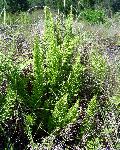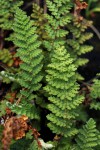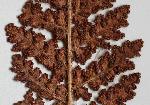Mohria vestita Baker
Synonyms |
Mohria caffrorum (L.) Desv. var. vestida (Baker) F.Ballard |
|---|---|
Common name |
|
Description |
Rhizome creeping, short, irregurlarly branched, up to 8(-10) mm in diameter; rhizome scales pale to chestnut brown, up to 1.7-7 mm long, ovate-lanceolate in outline, margin entire. Fronds closely spaced, yellow-green, erect, slightly dimorphic with fertile fronds longer than sterile fronds. Stipe 2-13.2 cm long, basally chestnut coloured, apically strawcoloured, set with hairs and scales, becoming glabrous at maturity. Lamina herbaceous to thinly coriaceous, up to 57 x 11 cm, erect, narrowly elliptic to narrowly oblanceolate in outline, 2-pinnatifid to 3-pinnatifid, with 10-29 pairs of pinnae. Pinnae above sparsely hairy on secondary rachis, below with hairs and long narrow scales; pinnule margins strongly toothed. Rhachis sparsely to densely set with scales; secondary rhachis below with hairs and scales, upper surface with hairs. Sori submarginal, partly covered by the reflexed pinnule margin, exindusiate. |
Notes | Difficult to distinguish from M. nudiuscula . M. vestita. has slightly more hairy pinnae, especially on the upper surface, and more strongly toothed margins. M. vestita is characterized by the short stipe/lamina ratio, the reduction in size of the pinnae towards the lamina base, hairs on the upper lamina surface are confined to the secondary rhachis and veins, twisted scales on the lower lamina surface are also confined to the secondary rhachis and veins. |
Derivation | vestita: clothed, referring to hair and scales on the plant; a character, however, shared by all species of Mohria. |
Habitat | Rocky places in grassveld or near waterfalls, mist forest, roadside-banks. |
Distribution worldwide | Africa, Madagascar |
Distribution in Africa |
Angola, Kenya, Lesotho, Malawi, Mozambique, South Africa, Swaziland, Tanzania , Zimbabwe. |
Growth form |
Lithophytic, terrestrial. |
Literature |
|




